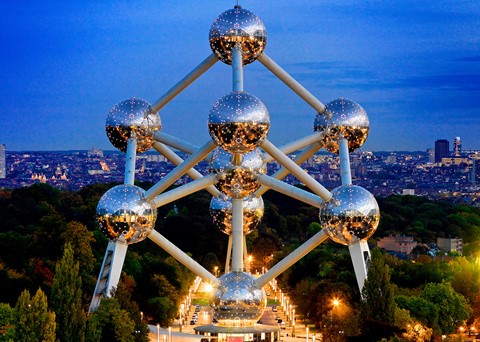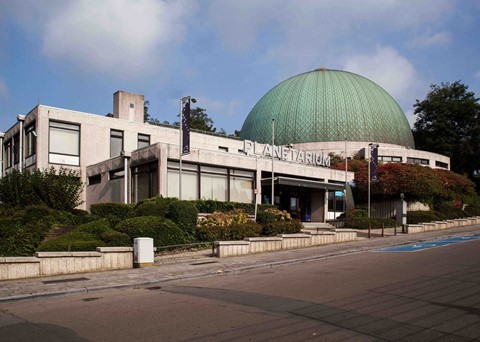Design Museum Brussels
Since 2015, the museum's collection, the Plastic Design Collection, circumscribes the landscape of plastics in design from the 1950s to the present day.
Alongside this collection, the museum opened belgisch design belge, a permanent exhibition space dedicated to Belgian design and its history.
Enriched by a programme of temporary exhibitions, the Design Museum Brussels also explores other fields of design creation and its impact on society and our daily lives.
Through exhibitions, guided tours, workshops, conferences and events, the museum aims to ensure that design is intelligible to one and all.

- Monday : -
- Tuesday : -
- Wednesday : -
- Thursday : -
- Friday : -
- Saturday : -
- Sunday : -
- T. +32 2 669 49 29
- Place de Belgique 1 Belgiëplein - 1020 Brussels
- https://designmuseum.brussels
- info@designmuseum.brussels

The Design Museum Brussels is a place dedicated to design and its history. Come and discover all the possibilities of design creation, in all its facets, from the 20th century to the present day. And get there by train, that's class!
------------------------
Enjoy this elegant train trip at a great price: buy your tickets for the Design Museum Brussels and get a 50% discount with the Discovery Ticket!
Buy your e-ticket at https://designmuseum.brussels/ and add a free Discovery Ticket voucher to your shopping basket.
Look out for the Discovery Ticket code on your Design Museum Brussels e-ticket: it's a 16-character code.
Order your Discovery Ticket here.
Print your Discovery Ticket or show the PDF on your smartphone screen when you check in on the train.
Enjoy your journey to Design Museum Brussels!
-
Opening times
14/03/2024 - 15/09/2024: * monday, tuesday, wednesday, thursday, friday, saturday and sunday: from 11:00 to 19:00
-
Price
Article 27: 1,25 €
Launched in June 2022, the Pastis collection designed for Danish publisher HAY marks a turning point in Julien Renault's career. The project began in February 2020 at the Stockholm Fair, when Rolf Hay asked Julien Renault to reflect on a wooden chair that would be relevant for the next 50 years. Inspired by the atmosphere of brasseries and grand railway station cafés, Julien Renault imagined a comfortable chair with armrests paying homage to everything we longed for during the lockdown. His intention was to create a timeless, robust, and elegant armchair. The collection is an ode to the social, the human, and to sharing. Two years will have passed between the first drawing and the launch of the complete collection on the market. On the occasion of his nomination as designer of the year 2023, Julien Renault is bringing together all the drawings, models, and prototypes representing the major stages in the development of his collection. The installation "The story behind the Pastis collection" aims to show the work that went into each product to the general public.
-
Opening times
10/04/2024 - 15/09/2024: * monday, tuesday, wednesday, thursday, friday, saturday and sunday: from 11:00 to 19:00
-
Price
Normal: 8,00 € - Article 27: 1,25 €
Since its founding in 1908, Olivetti has made a name for itself through the development of legendary products such as its typewriters, but also through its close relationship with the world of art. Belgian artist Jean-Michel Folon worked for Olivetti on numerous occasions over a period of almost three decades, producing posters and advertising products, as well as a number of immensely creative books and cartoons. The Olivetti · Folon exhibition, in collaboration with the Museo Civico Pier Alessandro Garda, the Associazione Archivio Storico Olivetti and the Fondation Folon, presents the rich artistic collaboration between the Italian design company Olivetti and the artist Jean-Michel Folon.
This summer, the Design Museum Brussels once again invites you to its Cine Design! This edition echoes our temporary exhibition Olivetti · Folon. On one hand, the documentary Folon offers an intimate and sensitive portrait of Belgian artist Jean-Michel Folon, author of the famous “bonhomme”. On the other, Prospettiva Olivetti and Paradigma Olivetti explore the singularity and creativity of the Italian design company, famous in particular for its typewriters, calculators and computers. Program: - 07.09 - 7:30 pm: Prospettiva Olivetti Davide Maffei 88', Italy, 2020 English - Italian - 22.08 - 7:30 pm: Folon Gaetan Saint-Remy 86', Belgium, 2021 French (subtitled) - 27.08 - 7:30 pm: Paradigma Olivetti Davide Maffei 88', Italy, 2020 English - Italian Initiated in 2020, Cine Design is a program of open-air screening of documentaries on the history of design, architecture and their major figures. In a summery and friendly atmosphere, the screenings take place in the garden of the Design Museum Brussels and are free. A food truck is present for your comfort. Just bring your seat or your blanket and enjoy the evening.
This summer, the Design Museum Brussels once again invites you to its Cine Design! This edition echoes our temporary exhibition Olivetti · Folon. On one hand, the documentary Folon offers an intimate and sensitive portrait of Belgian artist Jean-Michel Folon, author of the famous “bonhomme”. On the other, Prospettiva Olivetti and Paradigma Olivetti explore the singularity and creativity of the Italian design company, famous in particular for its typewriters, calculators and computers. On 22 August, the Design Museum Brussels invites you to the screening of Gaetan Saint-Remy’s documentary Folon. Folon portrays an unexpected, intimate and unique portrait of Jean-Michel Folon (1934-2005). A controversial and adulated artist, Folon is still recognised today as one of Belgium’s most influential artists of the first half of the 20th century. It is the artist himself who, through the use of unprecedented archives, tells his story. A debonair poet and a misunderstood artist, he was also highly ambitious and visionary. Folon presents us with his vision of art and the world, the tragedies of his life and his insatiable desire to meet new people and live new experiences. Thus, come together images loosely inspired by his work, his artworks (paintings, posters, photographs, drawings, sculptures, …), previously unseen archives, as well as interviews of family members, friends, artists and experts. Folon Gaetan Saint-Remy 86 minutes, Belgium, 2021 French Trailer: https://www.youtube.com/watch?v=-DDjhY7sLr0 Hungry or thirsty during the screening? Don’t panic! We’ve got it covered. A food truck will be on site to take care of you.
As part of the Through the eyes of program, external personalities offer their personal views on the exhibitions of the Design Museum Brussels. A unique customized visit where the choice of theme and approach is left to the speakers. Be inspired and guided by exceptional people who will help you see the exhibitions through a different lens. The museum invites you to discover our permanent exhibition belgisch design belge through the eyes of Julien Renault, Designer of the Year 2023. After training at the École Supérieure d’Art et de Design de Reims and the École Cantonale d’Arts de Lausanne, Julien Renault (b. 1985) became the Art Director at Kewlox, an iconic Belgian storage company, in 2016. Based in Brussels since 2009, his studio has been growing steadily, thanks to collaborations with international brands such as Cruso, Hay, Hem, Kewlox, and Mattiazzi. His creations lie somewhere between the artistic and the rational, the sensory and the sensible. On the occasion of his nomination as Designer of the Year 2023 by Knack Weekend and Le Vif Weekend magazines, the Design Museum Brussels welcomes and explores the creative process of the Pastis collection.
This summer, the Design Museum Brussels once again invites you to its Cine Design! This edition echoes our temporary exhibition Olivetti · Folon. On one hand, the documentary Folon offers an intimate and sensitive portrait of Belgian artist Jean-Michel Folon, author of the famous “bonhomme”. On the other, Prospettiva Olivetti and Paradigma Olivetti explore the singularity and creativity of the Italian design company, famous in particular for its typewriters, calculators and computers. On 27 August, the Design Museum Brussels invites you to the screening of Davide Maffei’s documentary Paradigma Olivetti. Founded in 1908 by Camillo Olivetti (1868-1943), Olivetti is an Italian company specialized in the manufacture of typewriters and calculators. His son, Adriano (1901-1960), who took over the firm in 1932, shaped the years that followed. He collaborated with many designers such as Marcello Nizzoli, Ettore Sottsass and Enzo Mari, producing objects that are still considered as iconic pieces such as the Valentine or the Lettera 22. Through the voices of designers, historians and various protagonists, and thanks to numerous archival documents, Paradigma Olivetti recounts the paths of Olivetti's industrial design, from Adriano's death to the 1990s, crossing the challenges of an era marked by rapid innovations such as the transition from mechanical to electronic technology. Paradigma Olivetti Davide Maffei 88 minutes, Italy, 2020 English - Italian Trailer : https://www.youtube.com/watch?v=XjCVqnF9Q7g Hungry or thirsty during the screening? Don’t panic! We’ve got it covered. A food truck will be on site to take care of you. With the collaboration and support of the Istituto Italiano di Cultura - Brussels.
-
Opening times
16/10/2024 - 09/03/2025: * monday, tuesday, wednesday, thursday, friday, saturday and sunday: from 11:00 to 19:00
-
Price
Normal: 8,00 € - Article 27: 1,25 €
From the pioneers of the Bauhaus to the interior designers of space capsules, as well as the classics of design, women have shaped the field of design, and yet are often overlooked. The Here We Are! Women in Design, 1900- Today exhibition pays tribute to women designers past and present, through a large collection of furniture, ceramics, glass, textiles, fashion and graphic design. Produced by the Vitra Design Museum, this exhibition is coming to the Design Museum Brussels with the addition of a section devoted to this issue in the history of design in Belgium.
-
Opening times
16/10/2024 - 13/04/2025: * monday, tuesday, wednesday, thursday, friday, saturday and sunday: from 11:00 to 19:00
Examples range from the overlooked productions of Maria Sèthe to the Belgian Art Nouveau to Hélène Denis-Bohy’s bold modern typography for her feminist pamphlets printed on the La Cambre printing press; from extraordinary Belle Époque ceramics by designers trained at Belgium’s first professional school for women to anonymous lacework in raffia made in Congolese missionary schools. The exhibition showcases the significant but under-valued creativity of women in diverse fields of crafts and design from an original, thematic approach. Through a focus on visibility, the show examines how women used design as a means of empowerment, signing their work, asserting their presence in exhibitions and making significant advancements in the field. Their work will be showcased as a testament to their resilience, innovation and creativity. Simultaneously, the exhibition addresses the challenges of invisibility faced by women designers. Their authorship was frequently obscured because of societal norms, social class, their behind-the-scenes work or within collaborative environments. This exploration will reveal instances where their contributions were overlooked, wrongly attributed or remained unrecognised, leading to a lack of knowledge of their work and its recognition. Moreover, this exhibition delves into the professionalisation of women designers, tracing their journey as they navigated educational institutions (as pupils and teachers), organisations and networks to establish themselves within professional circles. This journey highlights their determination and means to carve out a space for themselves in a predominantly male-dominated industry. Lastly, the realm of domesticity demonstrates how women, often from within and for the decoration of their homes, created their own visual and material culture and surroundings, which was in turn considered inferior or instrumentalised for moralistic purposes. They were driven by functional needs, tradition, so-called ‘virtue’ or a lack of suitable options in the commercial market. This exploration will underscore how women makers, whether as individuals or collectively, employed their ingenuity and resourcefulness to express their vision.













